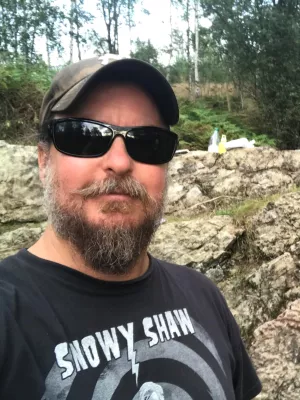
Mats Eriksson
Professor

Polychaete palaeoecology in an early Late Ordovician marine astrobleme of Sweden
Författare
Summary, in English
The post-impact Dalby Limestone (Kulcruse; Upper Ordovician) of the Tvaren crater, southeastern Sweden, has been analysed with regards to polychaetes, as represented by scolecodonts. A palaeoecological succession is observed in the Tvaren-2 drill core sequence, as the vacant ecospace was successively filled by a range of benthonic, nektonic and planktonic organisms. Scolecodonts belong to the first non-planktonic groups to appear and constitute one of the most abundant fossil elements. The polychacte assemblage recorded has an overall composition characteristic of that of the Upper Ordovician of Baltoscandia. Oenonites, Vistulella, Mochtyella and the enigmatic 'Xanioprion' represent the most common genera, whereas Pteropelta, Protarabellites?, Atraktoprion and Xanioprion are considerably more rare. The assemblage differs from coeval ones particularly in its poorly represented ramphoprionid fauna and the relatively high frequency of 'Xanioprion'. A taxonomic succession and changes in abundance and relative frequency of different taxa is observed from the deepest part of the crater and upwards towards more shallow water environments. The initial post-impact assemblage does not, however, necessarily represent a benthonic colonization of the crater floor. Instead it seems to be a taphocoenosis, as indicated by its taxonomic correspondence to the rim facies fauna recovered from Dalby Limestone erratics of the Ringson island. The Tvaren succession has yielded considerably richer scolecodont assemblages than hitherto recorded from the approximately coeval Lockne crater, possibly as a consequence of shallower water settings in the former area.
Avdelning/ar
- Berggrundsgeologi
Publiceringsår
2011
Språk
Engelska
Sidor
269-287
Publikation/Tidskrift/Serie
Geological Magazine
Volym
148
Issue
2
Dokumenttyp
Artikel i tidskrift
Förlag
Cambridge University Press
Ämne
- Geology
Nyckelord
- palaeoecology
- scolecodonts
- polychaetes
- impacts
- Kukruse
- Upper
- Ordovician
- Tvaren Bay
- Sweden
Status
Published
ISBN/ISSN/Övrigt
- ISSN: 0016-7568

